Are you trying to create a new post in WordPress? Do you want to learn about all the WordPress post features you see on your screen?
While some may think that adding a new WordPress post is quite self-explanatory, many beginners find the interface a bit overwhelming. Not to mention, sometimes even the more savvy users are surprised to find the hidden gems on the post edit screen.
In this beginner’s guide, we will walk you through all the features on the add new post screen, and how you can utilize them to create better content.
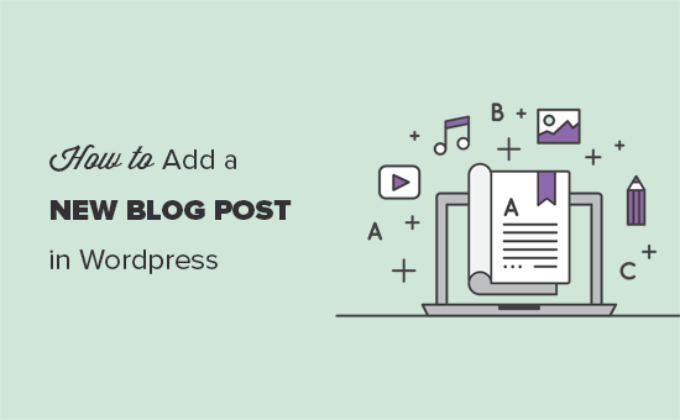
We have divided this guide into three sections to help you easily find what you’re looking for:
Ready, let’s get started.
Creating a New Post in WordPress Using The Default Editor
In December 2018, WordPress introduced a new modern block-based editor also known as Gutenberg. It is clean and simple, but don’t let the looks deceive you.
Behind its clean interface, there are tons of powerful features neatly tucked away. We’ll explain all of them and help you unlock their true potential.
Adding Title and Content Blocks
The WordPress block editor comes with a clean writing interface. At the top, you will enter your post’s title.
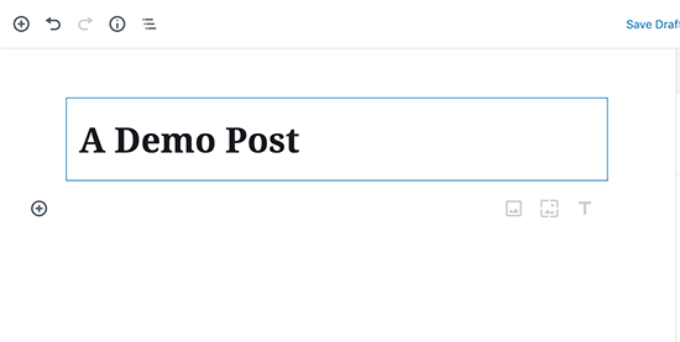
To add content, you need to add a block.
There are multiple add block buttons on the screen that you can click to select and add a block.
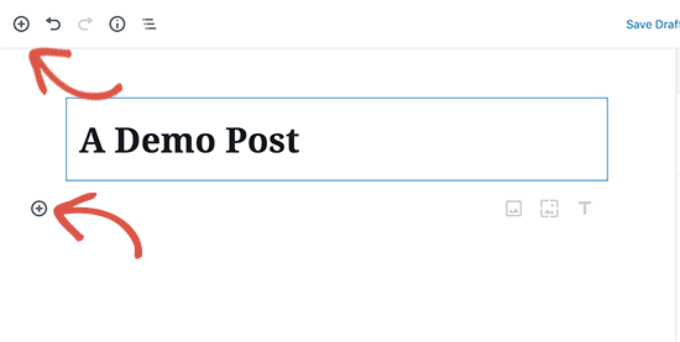
If you don’t want to use a mouse to click on the button, then you can use a keyboard shortcut.
Simply type / to search and add a block.
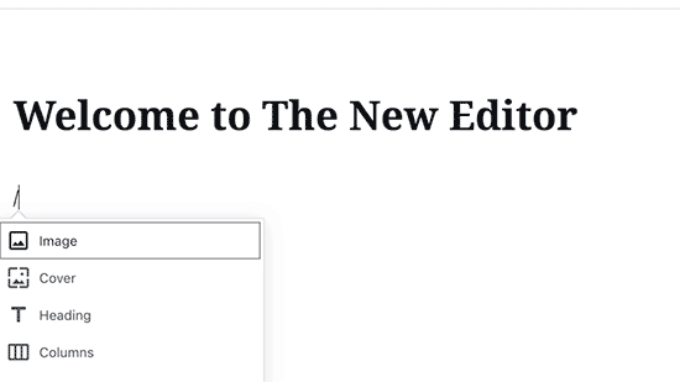
All content elements are wrapped in a block. WordPress comes with blocks for all the common content items, including paragraphs, columns, images, galleries, shortcodes, embeds, widgets, and more.
Some WordPress plugins may also add their own blocks to add other features like contact forms, SEO, etc (more on this later in the article).
Adding Images, Videos, & Other Media
You can add images by simply adding the image block and then uploading or selecting the image you want to add.

If you want to text and image next to each other, then you can use the ‘Media & Text’ block.
This block helps you wrap text around the image in WordPress.

WordPress editor also comes with a Gallery block that you can use to display images in rows and columns with a grid layout.
Simply add the Gallery block and then upload or select the images from your WordPress media library.
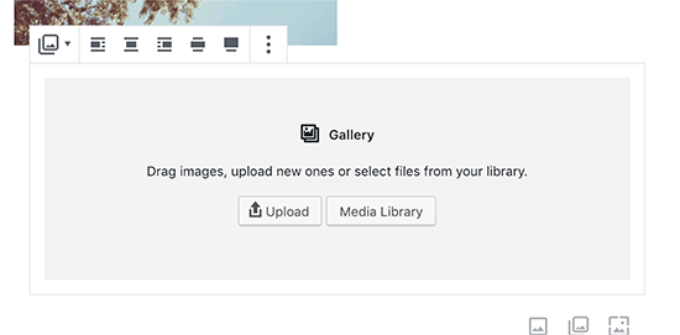
While the gallery block is powerful, you may need other advanced gallery features like albums, image sorting, etc. In that case, we recommend using one of these WordPress gallery plugins.
Want to embed a video in your content? No problem.
The default WordPress editor comes with embed blocks for all popular providers.
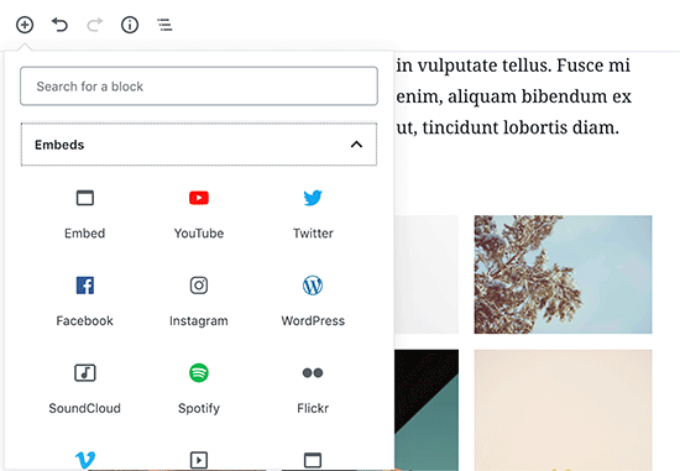
You can also just copy and paste the video URL to a paragraph block.
WordPress will automatically convert it into a video embed block.
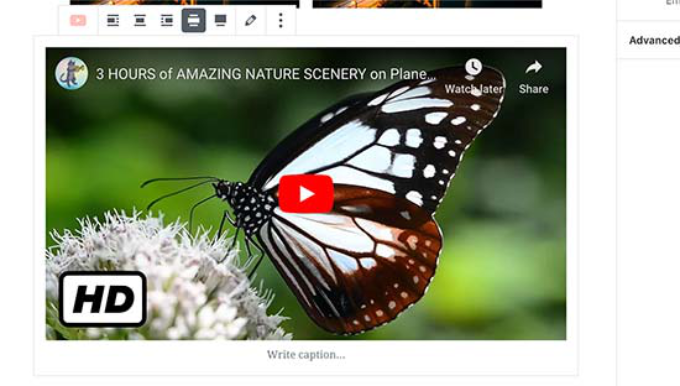
While you use the video block to upload videos directly to your website, we recommend against that because it will slow down your website and can even crash your WordPress hosting server.
Instead, we recommend uploading your videos on a service like YouTube or Vimeo, and then embedding it in your WordPress posts.
For more details, see our guide on why you should never upload videos to your WordPress site.
Adding Categories and Tags
WordPress allows you to sort your posts into categories and tags. These taxonomies help you organize your content into sections and topics.
They also help with WordPress SEO and make it easier for your users to find the content they are looking for.
The categories and tags meta boxes are located in the right-hand column.
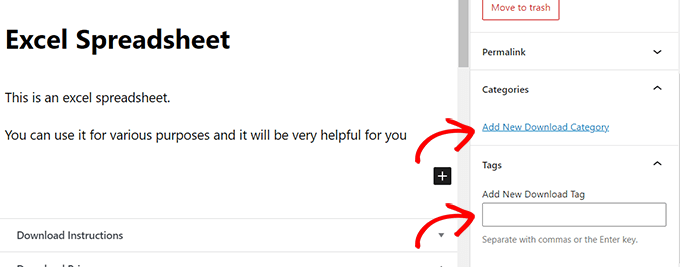
Adding Featured Image
A featured image (also known as a post thumbnail) is the main article image that represents the content. They’re prominently displayed on your website on single posts, blog archive pages, as well as on the homepage of news, magazine, and blog websites.
Almost all WordPress themes support the featured image functionality. You will find the option to add a featured image to your post in the right column.
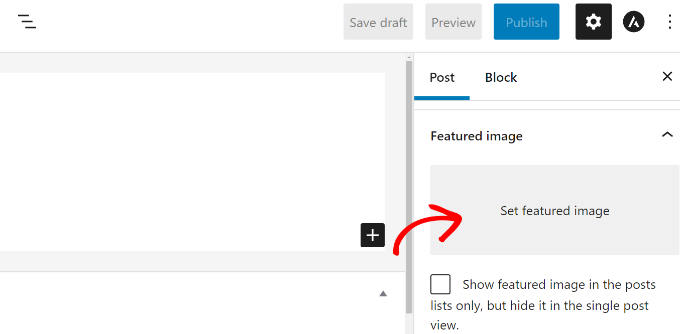
Simply click on the ‘Set featured image’ button and then select or upload the image you want to be used as the featured image.
It’s important that you don’t confuse featured images with cover images which is a new feature. See our article on cover image vs featured image for more details.
Adding Excerpts (Article Summary)
Excerpts are the summary of a blog post or article. Most WordPress themes can automatically generate the excerpt from the first few lines of your post.
However, this automatic excerpt may not always be meaningful or catchy. In that case, you may want to manually add an excerpt.
You can do so by adding it in the excerpt box located under the Settings column on the right.
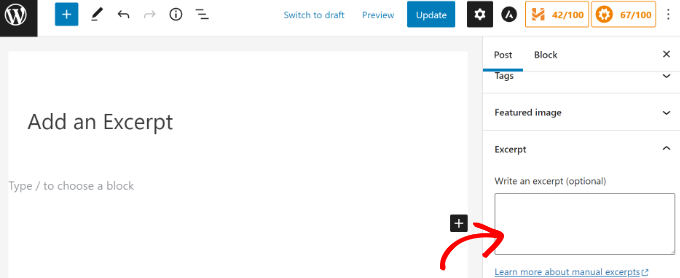
Changing Post URL Slug or Permalink
By default, WordPress uses SEO-friendly URLs for your blog posts. It automatically uses your post’s title as the permalink.
However, some users may want to change it to be more SEO and user-friendly. There are two ways to do that.
You can click on the post title, and you’ll notice the option to change the permalink above the title field. Alternatively, you can change it from the Permalink tab under the Settings column.
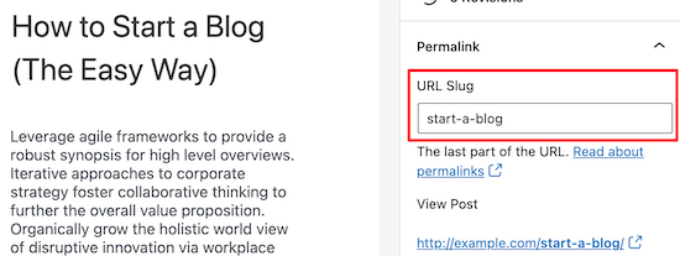
Changing Author
If you run a multi-author WordPress site, then you can also change a post’s author and assign it to a different author on your website.
You will find the option to change author under Settings in the right column.

Turn Comments On / Off
WordPress comes with a built-in commenting system that allows users to leave comments on your post.
You can turn off comments for individual posts from the Discussion tab. Simply uncheck the ‘Allow comments’ option.
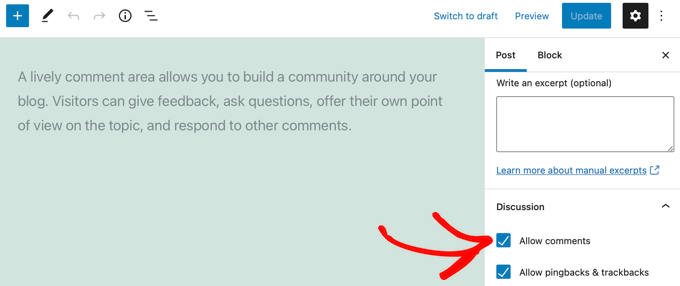
You’ll also see the option to allow pingbacks and trackbacks. These allow you and other blogs to notify each other when they link to an article.
However, it is mostly used for spam, so we recommend completely disabling pingbacks and trackbacks.
Options Added by WordPress Plugins
Most popular WordPress plugins will also add their own options to the post edit screen. Some will be available as blocks while others will be available as meta boxes.
For example, WPForms, the best WordPress contact form plugin adds a block to insert contact forms in your posts and pages.

Another great example would be All in One SEO (AIOSEO). They add a meta box below the editor for SEO settings and another one in the top toolbar.
You read our full guide on how to setup All in One SEO for WordPress for more details.
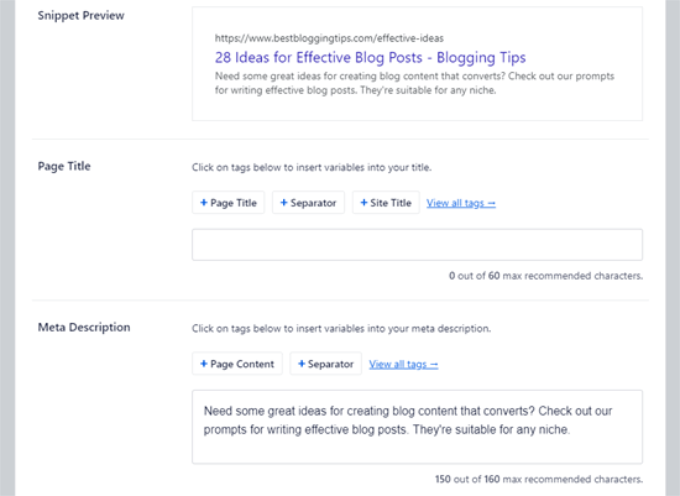
Publishing Options
The default WordPress edit screen is divided into two columns. The left column is where you write content, and the right column has all post settings including publishing options.
Let’s take a look at publishing options in the right column.

- The ‘Save’ button allows you to quickly save changes you made to a WordPress post. The editor will also automatically save your changes as you write.
- The preview button will open a live preview of your post or page in a new browser tab.
- Once you are done editing your post, you can click on the Publish button to make your post go live.
- WordPress gives you a few options to control the visibility of your post. The default option is ‘Public’ but clicking on it will show you options to make a post private or password protected.

- WordPress also allows you to control when a post is published. The default option is to publish immediately, but you can also schedule your posts to publish later or even select a past date.

- Checking the box next to ‘Stick to front page’ will make a post sticky or featured. This makes the specific post appear on top of other posts.
- Pending review option will add a custom status next to your post as ‘Pending review’. This feature is particularly helpful on multi-author blogs where contributors can just save posts and not publish them.
- If you want to delete a post, then you can click on the ‘Move to trash’ button. WordPress will send the post to the trash. Deleted posts will remain in the trash folder for up to 30 days. After that, they will be deleted permanently.
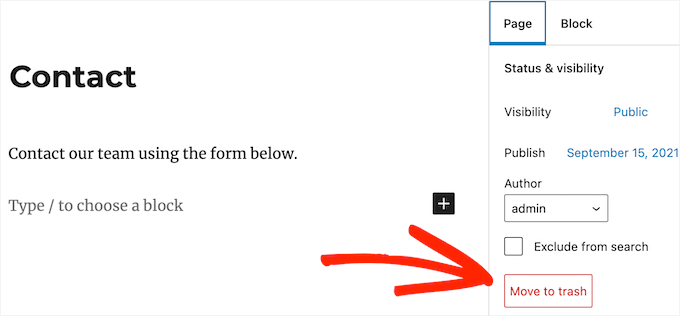
Edit Screen Options
WordPress allows you to show and hide panels from the edit screen.
You can do so by clicking on the three-dot menu at the top-right corner of the screen and then clicking on the ‘Options’ button.
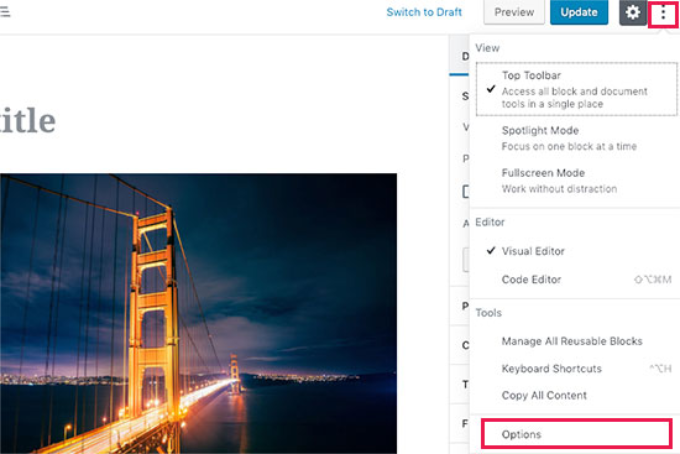
This will bring up a popup.
Here, you can check or uncheck the panels you’d like to view.
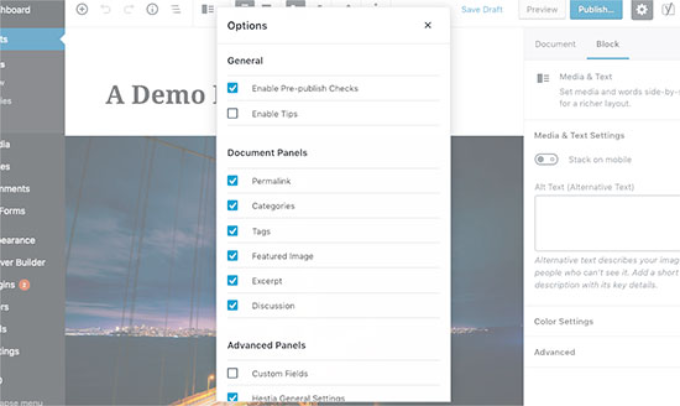
Other Post Edit Screen Options
There are many other options on the post edit screen. Most of them are related to the appearance of the post edit screen and the editor itself.
Let’s explore them.
When you click on the three-dot menu icon at the top right corner of the screen, you will see options to move block toolbar to the top, spotlight mode, fullscreen mode, switch between visual editor or code editor, manage reusable blocks, and keyboard shortcuts.
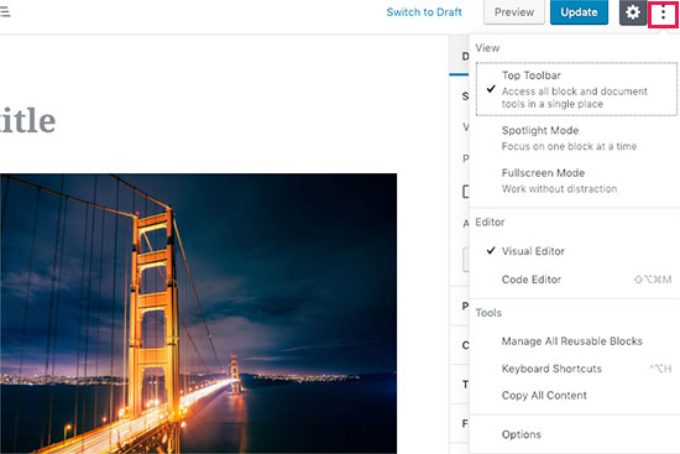
Next to it, you will see a button with the gear icon.
Clicking on it will show/hide the block settings column.
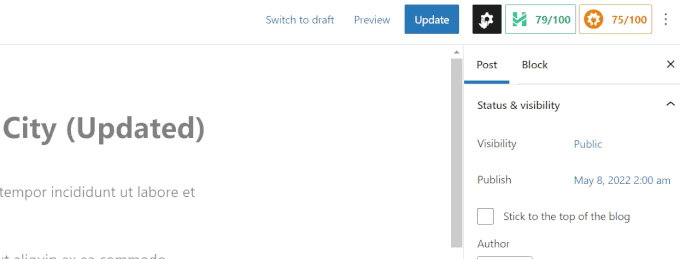
On the top-left corner of the screen, there are a few more buttons.
First, from the right, you will see the block navigation button which allows you to quickly jump to a block in your post.
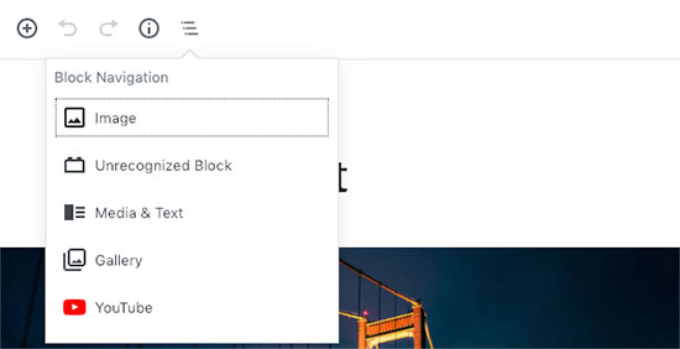
Next, you will see the information icon.
Clicking on it will show you post stats like the number of words, paragraphs, headings, and blocks.
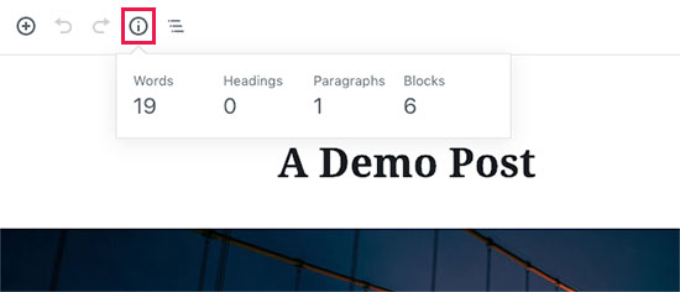
After that, you have Undo and Redo buttons
They allow you to undo changes you made to your posts before saving or publishing them.

Finally, you have the add block button which allows you to insert blocks to the post editor.
The default WordPress editor is quite powerful.
We encourage you to explore it on your own when writing blog posts and pay attention to the individual block settings. Each block has different settings, and you’ll discover a lot of neat tricks there.
Creating a New Post in WordPress Using The Classic Editor
If you are still using the old classic WordPress editor, then this section is for you.
The classic editor will be supported until the end of 2021, and we strongly recommend all users to create a plan for switching to the new WordPress editor.
Title and Content Boxes
In the classic editor, title and content boxes are the most noticeable areas on the Add New Post screen (see the screenshot below).
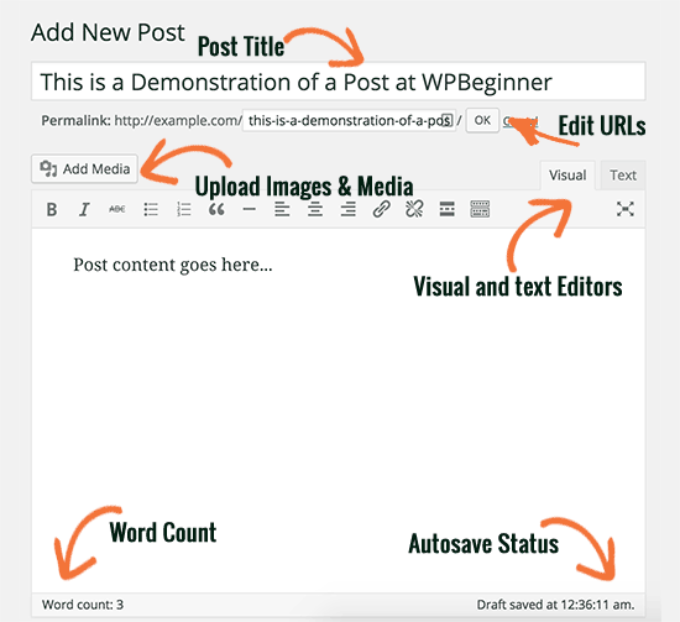
Yours might look slightly different depending on whether you are using the visual or the text editor.
You can switch between visual and a text editor while writing a post, but we do not recommend switching as this could mess up your post’s formatting.
Visual Editor is a beginner-friendly text editor with formatting buttons and a nice visual layout for the content area. On the other hand, the text editor is a plain text editor where you can actually see the HTML or write your own.
The first text area on the top is where you add the post title. If you are using SEO Friendly URL structure, then WordPress will auto-generate the post URL based on your title. You can edit the URL by clicking on the edit button.
The content area is where you will write your post. You can use the formatting options from the toolbar or use one of the many keyboard shortcuts available which will speed up your writing process.
If you are using the visual editor, then you may want to take a look at these tips for mastering the WordPress visual editor.
In the footer area of the content editor, WordPress will show you the word count for your post. This is especially useful if you’re writing a guest post or an article that needs to meet a certain number of words.
As you write, WordPress will automatically save a draft of your post. This autosave is stored in your WordPress database temporarily.
As soon as you save your draft or write more content, WordPress cleans up your autosave temporary draft and replaces it with a new one. This process ensures that you do not lose your content due to an internet connection or hardware failure. See our guide on how to undo changes in WordPress with post revisions.
The post editor shows your current draft and autosave status in the footer next to the word count.
Add Images and Media
Between the title and content fields, there is a large Add Media button. You will need to click on it when you want to upload an image or any other media to your WordPress post. This will launch the media uploader in a popup window.
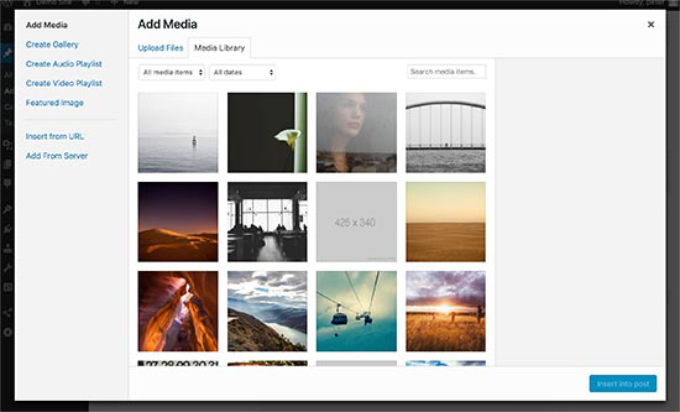
Simply click on the select files button to upload images or any other media to your WordPress site. You can also create image galleries from uploaded files.
WordPress comes with some basic image editing tools. See our tutorial on how to edit, flip, rotate, and crop images in WordPress.
Publishing Options
The WordPress post edit screen is divided into two columns. The column on your left contains the post title and content editor. On your right-hand side, you have different meta boxes to configure post settings.
The top meta box in this column is labeled Publish. This is where all the publishing options for your posts are managed.
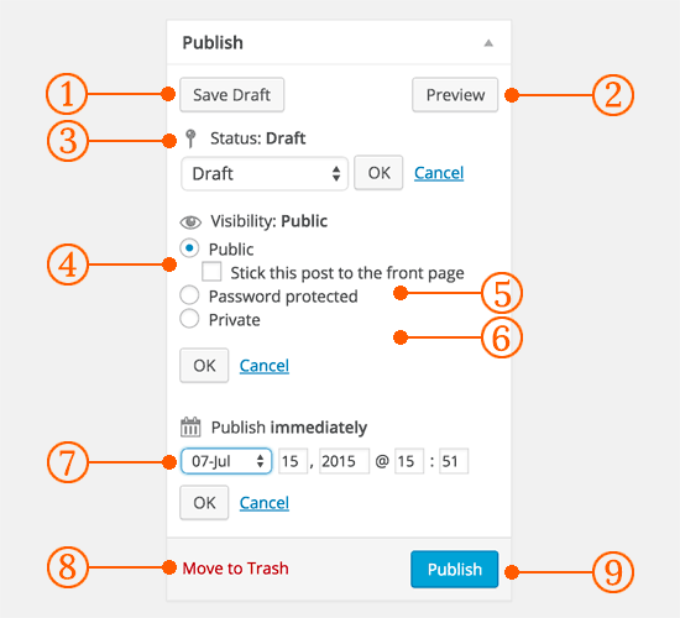
1. Save Draft button stores a draft of the post or page that you are working on. WordPress also auto-saves your posts as you write them.
2. Preview button shows a live preview of your post. You can use it to see how your post will look after publishing.
3. Status allows you to set a status for your post. WordPress automatically handles post status for drafts and published posts. Unless you are using a plugin to add custom statuses, you don’t need to worry about this option.
4. Click on the Edit link next to visibility to expand it. The first option under visibility will allow you to make your post sticky on front-page. Sticky posts in WordPress are like featured content that are displayed on top of all other posts.
5. The next option allows you to password protect a post in WordPress.
6. The third option under visibility is labeled private. This allows you to privately publish a post on your WordPress site. The private posts will be visible to users who have the editing privileges on your site.
7. Click on the edit link next to Publish, and WordPress will display the time and date options. You can use this option to schedule posts or create back dated post in WordPress.
8. Move to trash allows you to delete a WordPress post. Deleted posts live under trash, and you can restore them if you need to for up to 30 days.
9. Finally, the publish button makes your WordPress post public. Remember if you scheduled a post, then it will appear on your site on the scheduled date and time.
Adding Categories and Tags
You can sort your posts into categories and tags. The categories and tags meta boxes usually appear in the right-hand column below publish meta box.
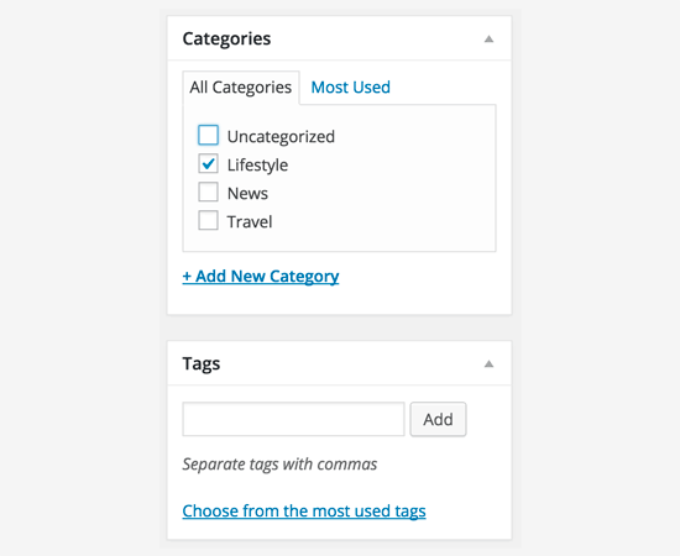
Categories and tags help you organize your content in a meaningful and browsable format.
Not only does it help users easily find your content, but it also boosts your site’s SEO. See our guide on the difference between categories and tags and how to use them to sort your content.
Featured Image (Post Thumbnails)
Most WordPress themes support featured images or post thumbnails for articles. Usually, it is the last box in the right column on your post edit screen.
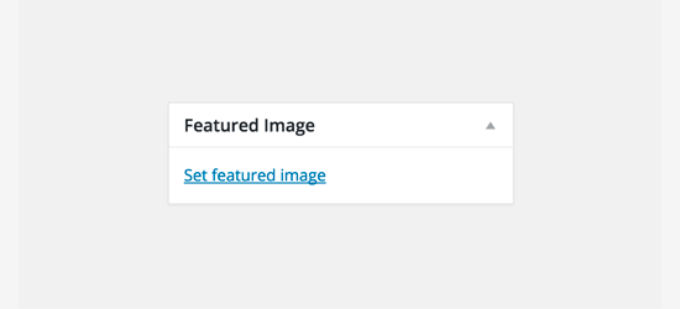
Simply click on the set featured image link, and it will bring up the media uploader popup. You can select an image from your previous uploads or upload a new image from your computer.
For more detailed instructions, see our guide on how to add featured image or post thumbnails in WordPress.
Screen Options
Some of the options on the post edit screen are hidden by default to present a cleaner and simpler editing experience. These options are not commonly used by beginners. However, you may need them later.
Simply click on the Screen Options button on the top right corner of the page. This will show a menu with checkboxes next to option names.

As you can see some of the options will already be checked. For the others, you can display them by clicking on the checkbox next to an option name, and it will appear on your post edit page.
Let’s take a look at some of these options and what they do.
Excerpts
Checking this box adds a meta box below your content editor. You can use this box to add a short summary or excerpt for your post.
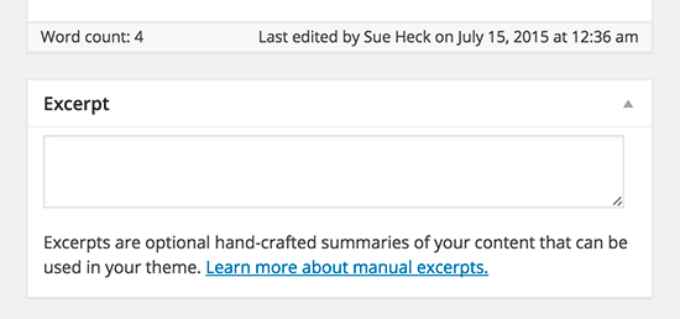
Ideally, you should display a summary or excerpt for your posts on your site’s front page and archives. Full content should only be displayed on the post’s single page.
Learn more about this in our guide full post vs summary (excerpt) in your WordPress archive pages.
Send Trackbacks
Send Trackbacks option allows you to notify other blog owners that you have linked to their content.
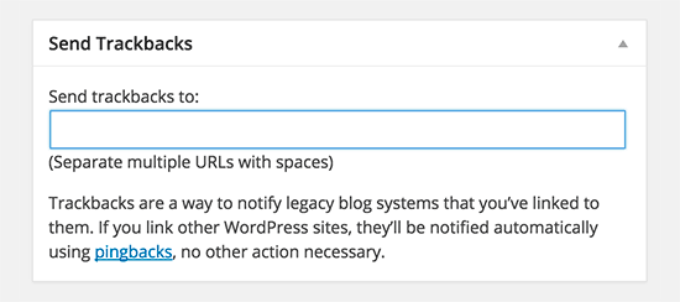
If the other blog owner is running WordPress, then you don’t need to send them trackbacks. Your WordPress site will automatically send them a ping when you publish the post.
Trackback feature is misused by spammers so much that many site owners simply disable them. We have an article on dealing with trackback spam in WordPress.
Custom Fields
This option will display a user interface for custom fields below your post editor. You can use it to manually enter custom information in your posts. See our WordPress custom fields 101 guide for beginners to learn more.

Discussion
While comments are a great way to engage your audience, sometimes you may not want to have comments on a specific post or a page.
The discussion option displays a meta box below the post editor to turn on/off comments and pingbacks for your post.

Since pages are supposed to be like static pages, most users want to turn off comments on them. You can do so by editing each page, or you can see this tutorial to turn off/disable comments on WordPress pages.
Once your WordPress site gets some reputation, you will start getting an increase of comment spam. Instead of turning off comments, you may want to try these tips and tools to combat comment spam in WordPress.
Slug
A slug is a cleaner title that can be used in URLs.
http://example.com/2015/07/this-is-post-slug
WordPress automatically generates a post slug and displays it as the post URL just below the post title. You can edit the URL slug by clicking on the edit link below the post title.
You can also enable the slug option from the Screen Options and edit your post slug there.
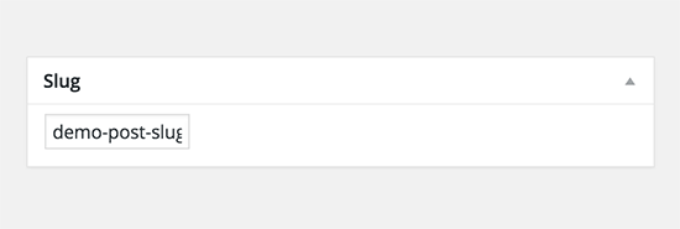
Author
WordPress will automatically assign you as the post author when you create a post.
However, sometimes you may want to show another user on your WordPress site as the author. Enabling the author checkbox allows you to do that from the post edit screen.

Bonus Tips for Creating Better Blog Posts
The reason why WordPress is the most popular blogging platform is because it comes with a great set of tools right out of the box to help you create new content.
However, there are many other tools and tips that you can use to improve your blog content.
The first tip we offer to everyone who’s just starting a blog is consistency. Make sure that you regularly publish blog posts. You can plan an editorial calendar and then stick to it.
We recommend starting with 1 – 2 posts a week and then gradually increasing your pace.
Often new users struggle with finding post ideas for their blog. Here is a massive list of blog post ideas that you can use to get started. You can also use WPBeginner’s free blog post idea generator to get 250+ new ideas instantly.
You’ll also need to learn how to promote your posts and keep track of things. Our team has picked the best content marketing tools that will help you grow your blog.
Lastly, you can optimize your website for search engines like Google. This is where AIOSEO comes in handy, as it helps with search engine optimization (SEO) without any technical knowledge. You can rank for different keywords and drive organic traffic to your blog.
Often users ask us what’s the difference between posts vs pages, and which one is better for SEO? The simple answer is that it depends. Posts are timely content organized in a reverse chronological order which is why they’re called blog posts.
Pages on the other hand are static content such as your about page, contact page, etc. The process of adding a new post or page in WordPress is exactly the same.
For more details, see our guide on post vs pages in WordPress.
Video Tutorial
We hope this article helped you learn how to add a new post in WordPress like a pro. You may also want to see our essential WordPress SEO guide for and the best email marketing services for small businesses.
If you liked this article, then please subscribe to our YouTube Channel for WordPress video tutorials. You can also find us on Twitter and Facebook.





Soms
hi Wpbeginner,
I would like to know if there’s any tool or AI that help to generate content or help to check grammatical fault while writing a post in wordpress.
thanks.
WPBeginner Comments
The best tool we found for checking grammar and spelling mistakes is called Grammarly. We happen to have a guide on Grammarly here: https://www.wpbeginner.com/plugins/how-to-check-grammar-and-spelling-mistakes-in-wordpress/
Charlie
Hello,
I’m getting an error message (not a valid JSON response) when I try to create a new post on my wordpress site. Any tips?
Thanks
WPBeginner Support
You would want to take a look at our guide on fixing that error below:
https://www.wpbeginner.com/wp-tutorials/how-to-fix-the-invalid-json-error-in-wordpress-beginners-guide/
Admin
Dominick smith
I really love your bog and there is no doubt that it is the very hepful one for us
WPBeginner Support
Glad our guide was helpful
Admin
ogunyinka ezekiel
good and understanding…it is well encouraging as a biginner in website development.
WPBeginner Support
Glad you found our guide helpful
Admin
My Real Name
Doesn’t actually show how to “Add New Post”
WPBeginner Support
Apologies for any confusion, you would want to go under Posts>Add New in the wp-admin area of your site to add a new post.
Admin
Abhijit Bangal
Hi team,
I’m a regular reader of your blog, though, I don’t go much into editing as your posts guide for various querries. But this time, I was looking for a way to make a template/theme so that I can get that particular setting I want. For example, I want to start with a particular font size, or if I add a new paragraph, it automatically gets the alighnment/color/font size, etc. what I have saved somewhere in the setting. Is something like this possible?
I am using the new blocks type. Not the old classic.
Thank you!
WPBeginner Support
That would be determined by your specific theme and the CSS it has applied.
Admin
James Emmanuel
Nice guide, I was wondering, by creating a post, is there a way to add related post on a post automatically?
WPBeginner Support
You would want to look into related post plugins for that.
Admin
Ren Jianjun
thanks for your articles. Can you help me how about my this post writing?
example.com/2019/03/13/name/
if i want to delete the 2019/03/13, how to do next?
WPBeginner Support
That would be determined by your permalinks, you would want to take a look at our guide here: https://www.wpbeginner.com/wp-tutorials/how-to-create-custom-permalinks-in-wordpress/
Admin
Ryan
I appreciate the tips and I’ve got how to publish a post, however how do link “posts” to my “blog” menu?
WPBeginner Support
For what it sounds like you’re wanting, you would want to check our article here: https://www.wpbeginner.com/wp-tutorials/how-to-create-a-separate-page-for-blog-posts-in-wordpress/
Admin
Sue Fone
I’ve been doing fine publishing my Blogs for the past couple of years and all of a sudden I’m lost. I copy and past to get my Blogs in. Now EVERY sentence is in a paragraph box. It won’t let me do paragraphs anymore. EVERY sentence is in a box and the next sentence is double spaced and in a box of it’s own. All my paragraphs are separated into sentences standing alone. Please help me. I’m SO frustrated. sf
WPBeginner Support
It sounds like you are currently in the block editor: https://www.wpbeginner.com/beginners-guide/how-to-use-the-new-wordpress-block-editor/
You can disable the new editor and revert to the classic editor using:
https://www.wpbeginner.com/plugins/how-to-disable-gutenberg-and-keep-the-classic-editor-in-wordpress/
Admin
Rachid
hello
in new editor :
how to add google adsense inside article as a shortcode in new editor .
I tryed to put it as
[/]
Html code
script
but no thing displayed.
by the way I don’t have any problem with my google adsense account every thing is okay .
in old editor I use function to insert ads in article.
thanks
WPBeginner Support
There is a custom HTML block that you can use to add HTML to a post or page
Admin
Sajjad Ahmad
Your tips are helpful . Wordpress website crashes seen after few weeks that damaging the ranking and also needs extra efforts to restore it again. How to manage a clean and media crash free site ?
WPBeginner Support
It would depend on why your site is crashing if it is due to a plugin or theme you would want to reach out to its support. You can clean your database using: https://www.wpbeginner.com/plugins/how-to-clean-up-your-wordpress-database-for-improved-performance/
Admin
Rashmi sangal
Read more of the post overlaps with the contents of the post please help
WPBeginner Support
For an error like that one, you would want to reach out to the support for your specific theme and they should be able to assist.
Admin
Oluwafemi Emmanuel
very good article….learnt quite a few things, but i have an issue with my upload….i cant upload images and neither can i set Featured images. this started yesterday…my blog is just 1 week old. please what can i do?
WPBeginner Support
The most common reason would be you are running into a HTTP error which can be fixed using our article: https://www.wpbeginner.com/wp-tutorials/how-to-fix-the-http-image-upload-error-in-wordpress/
Admin
Vanessa
I have set up my blog now and everything is fine, except that when I go to the site it says “A new wordpress site coming soon.” How do I activate the site to show my posts and pages? Thanks
WPBeginner Support
Hi Vanessa,
This could be a DNS issue with your domain name. Please contact your WordPress hosting provider and they will be able to assist you better.
Admin
RazS
Hi,
I have a website built in WP with Woocommerce. I am trying to allow registered users (email/username) to leave blog comments/entries and comment on other people’s entries WITHOUT DOING IT THROUGH THE WP Admin Panel. Is that possible? What would it take (programming)?
Thanks
vijay
Hi
I want to set featured image below post title in single post page? what should i do.
alihamdan
I totally agree with Jasmine above. My posting experience just completely changed and I don’t know what is going on. Whatever it is, Jasmine didn’t make it up and I have the same problem.
peris
The article is indeed a great resource for newbies using WordPress.
Nonetheless, I have a problem that probably most other newbies are having. Kindly respond to it.
My blog is. And it’s still quite new. I have published several posts, categories and some pages and sub pages up there.
Now, my issue is; I would love to link my posts to those sub pages. For instance on the page Food and subpage recipes , I want by the client of recipes there’s a drop down of all posts related to the same.
I have already linked my posts to categories but still nothing works.
kindly kindly help
emily
I’m having trouble publishing on my blog. Actually, I can’t at all. Your directions here say “The top most meta box in this column is labeled Publish. This is where all the publishing options for your posts are managed.” But when I try it, the top most box is “status.” “Publish” is nowhere to be found. What happened? Am I in wordpress jail for some reason and not allowed to publish? Is there something wrong with my computer or software or browser?
emily
actually, while writing this comment, i got the idea to try a different browser. so the good news is it works in firefox. but i’m still not having any luck with chrome. am i the only one with this problem?
Alberto rosado
Good morning. I want to schedule my post in advance. I have watched every video about scheduling but in my site I don’t have the scheduling button. What I see in my site is a sign with publicize not connected. Could you tell me what the problem is?
Nick
Hello,
Great article here. Am a newbie and been trying to upload post but the problem is, my article has few images example 5 Best Cities to Visit. I don’t know how I can insert the images.
Can you help and show me how ??
Thank you
WPBeginner Support
Hey Nick,
You will need to click on the ‘Add Media’ button to select and upload an image from your computer and then click on insert button to add the image into your post. You can also select multiple images at once and create a gallery.
Admin
Andrew
I’m looking for some advice as to how I can post to my website directly under specific pages. I found a plug in called “Post-in Pages” but it doesn’t seem to offer any help/ guidance as to how to use it.
Essentially, all I want to do is post product links under a “product” page.
Why wordpress doesn’t make it blatantly obvious how to do this, is beyond me!
Any links to videos or a direct message is much appreciated! Thanks
Anis
You can’t post to a page directly, if you already created a page as product, simply remove it and create a category with the same name. After creating the new category, go to menu, click on categories, select the “products” category you just created, and then add to menu.
Finally, refresh your site
Emma Taylor
Great article. Thanks
Shoaib AHmad
Hi dear
What i will do after to publish a blog.i mean what work will remain after publishing to manage the wp blog..thanx
Shoaib ahmad
I am really glad to see ur tutorial. I just a beginner and face some dashboard setting problems. Now many problems are solve so thanx for u
Aman Thakur
how to log in to word press
WPBeginner Support
Please see our guide on how to find your WordPress login URL.
Admin
Justin Mally
Well written and informative.
Justin Mally
Good article. Why has WP changed? It was much easier to use earlier.
Pam Winegar
This is for
What happened to writing a post? It isn’t the same at all. I insert lots of images all the time. I could control size. Now I don’t see how. And to tell you the truth, I don’t even see “save draft” anymore. This happened since my last post 8 days ago. Help!
Pam Winegar
As a follow-up to my comment above, I did find the + and – to make the image big and small. When I made the image smaller, it dropped the caption I gave it and now the two captions for two different pictures are the same. You can look it up yourself in my current draft for Empire State Building. How can I go back to adding posts the way I did before?
Pam Winegar
I found my own answer. In case anyone else has the same problem, I added a new post the regular way by clicking on WP Admin and then adding the new post.
WPBeginner Support
Please see our guide on the difference between self hosted WordPress.org vs free WordPress.com blog.
Admin
Sonam Meena
Hello Wpbeginner
how to add Heading Tags In Post ???????
because there is no Heading tags tab in post section
help me
Jasmine Honey Adams
Could you possibly do a post about using the “new posting experience” that’s unexpectedly been foisted on us all this week? I only ask because it’s all changed and that big “add media” button has vanished, it appears that the only way to put a picture in is to either set it as a featured image or to revert to using the oldest old posting experience which as a previous commenter pointed out, has some formatting issues. I arrived at this tutorial from a web search looking for how to use the newest “posting experience,” and I would bet other people have as well. Having used WP for over a year, I now feel like a total noob again because this “new posting experience” has just arrived and didn’t even come with a “take the tour” or “tutorial” or even “mouseover the ? for help” type explanation. Perhaps you could help out those of us who are bad at figuring it out for ourselves?
Best Wishes,
Jasmine.
WPBeginner Support
We don’t understand what new posting experience you are talking about. You can try this very basic troubleshooting tip. Deactivate all your WordPress plugins and then switch to a default theme. Visit the post editor to see if this resolved the issue. If it does, then this means that the issue was caused by a plugin or your WordPress theme. If it does not resolve the issue, then report back and we can troubleshoot it further.
Admin
Pam Winegar
I totally agree with Jasmine above. My posting experience just completely changed and I don’t know what is going on. Whatever it is, Jasmine didn’t make it up and I have the same problem.
Anil
Many thanks for this post
Sarah
Thank you for this info. I’m a really newbie blogger and am just trying to figure out what I’m doing and how to use Wordpress properly. I think this site is going to be invaluable – just what I need simple clear info for a tech challenged person. I can already see a tonne of things that I can work on.
imon
Is it similar with a new page creation as with new WordPress Post creation?
WPBeginner Support
Yes except that you cannot choose categories or tags for a page by default. When creating a page you can also make it a parent or child page as well. See our guide on the difference between WordPress posts vs pages.
Admin
Andy Clark
I’ve always wondered why they don’t put a more featured calendar control on that form for scheduling posts. I mostly want to post things, “next Friday” or “on Wednesday” without needing to calculate the dates myself.
WPBeginner Support
Have you tried Edit Flow? We use it to visualize our editorial calendar.
Admin
Irene Anum
Many thanks for this post which has taught me things i didnt know or overlooked. ill use them to make my site better.
Connor Rickett
I’m just patiently (less patiently than two versions ago) waiting for them to create an editor which reliably shows what the spacing and formatting will look like in the actual post. And doesn’t override the custom tags you add every time you switch over into the basic visual editor tab.
WordPress is great overall, but that one thing is immensely frustrating; the primary purpose of a blog is to write content. The writing bit should, therefor, be flawless.